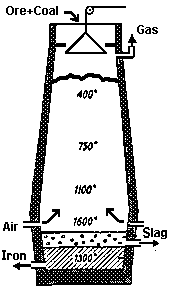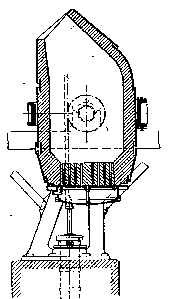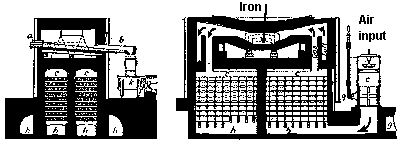|
Basic Steps
|
Iron is produced from ore in two steps. First ore is mixed with charcoal
(or coke) in a blastfurnace and heated to high temperature to get iron. Then
this iron is further processed to reduce carbon and slag, and to add alloys.
|
There are many alternate methods that has been used throughout history for
those two steps. When charcoal was used, countries with both iron ore and
large forests (like Sweden) had an advantage.
|
|
|
Blast-furnace
|

|
Iron ore and charcoal (or coke) are charged from the top. Air is blown in
at the bottom. The coal burns to CO which reacts with the ore and reduces
it.
In principle:
Fe3O4 + CO --> Fe + CO2
The waste rock in the ore is lighter than iron and floats as slag. The melted
iron and slag are tapped at the bottom.
(GIF-image 3k)
Blast-furnaces have been used since the 12th century. Their size has increased.
Charcoal was first used, but from around 1800 coke could be used.
|
|
|
Iron and Steel
|

|
To obtain high quality iron and steel from the the blast-furnace iron (pig
iron), it is heated and treated with air or pure oxygen. Left a Bessemer
converter where air is blown in at bottom and passes through melted iron.
Below a Siemens-Martin furnace where air goes into a pre-heater
(regenerator) and passes above the melted iron and then onto another regenerator
which gets heated. The direction of the air flow is changed after a time
to make use of the heat! Both methods were invented around 1860.
(GIF-images 4k+4k)
|
|
|

|
|
Older Methods
|
Older methods were based on heating and hammering. One used water-wheels
to drive the hammers. The pig iron blocks were heated in a hearth and hammered
to long thin pieces (rod iron). See images on following page.
|
|
|
Number of Plants
|
To-day. Now there are only two iron mines: in Sweden Kiruna
and Malmberget, both in the northmost part of Sweden. The last two mines
in southern Sweden were Grängesberg closed 1989 and Dannemora closed
1992 (D. had been in production since the 13th century!).
There are also only two ironworks with blast-furnaces, one in Luleå
and one in Oxelösund.
|
Old times. There have been hundreds of iron mines and blast-furnaces,
and around thousand iron mills. Most of them in Bergslagen (far north-west
of Stockholm, see map on Early Railways-page). This reduction has of course
meant enormous changes for the people working in the Bergslag region. However,
manufacturing of products based on iron is still very important in the region.
|
|


